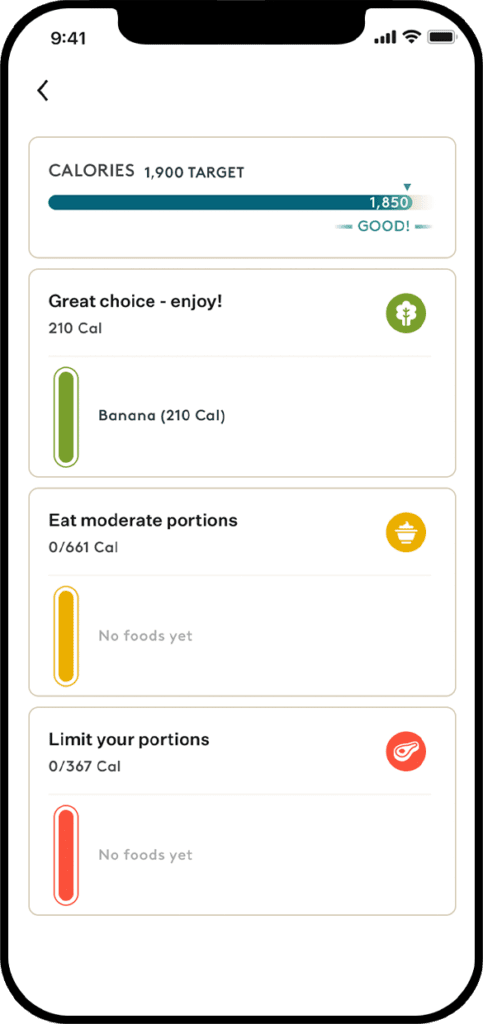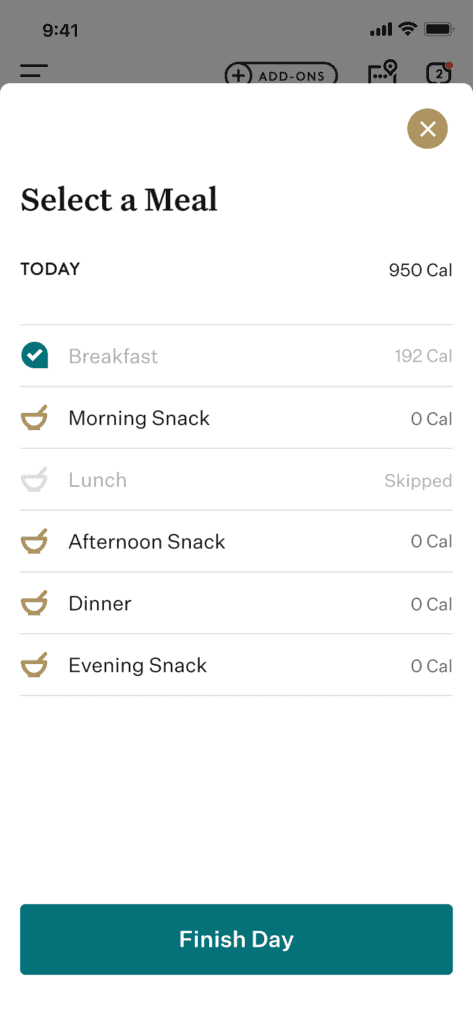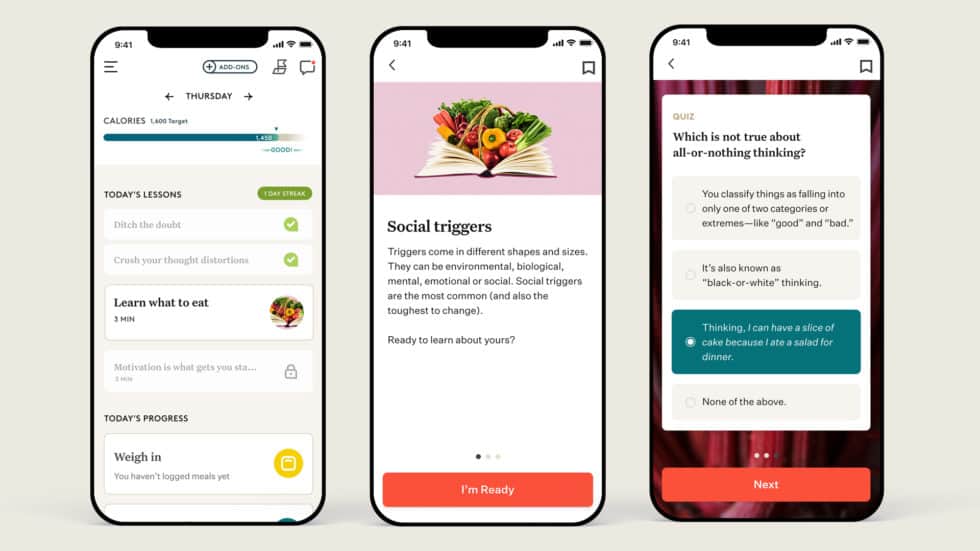- If you’re in a calorie deficit but not losing weight, be patient with yourself. Plateaus are a normal part of the weight loss process.
- Noom Weight can help you push past plateaus with psychology-backed lessons, 1:1 coaching, food logging, and other tools.
- If you stick with a calorie deficit plan, you will likely continue to lose weight overall (despite the inevitable ups and downs).
The key to weight loss is consuming fewer calories than you burn—otherwise known as a calorie deficit.
When a calorie deficit is maintained consistently, you should start to lose weight.
That initial weight loss might come easily. You get excited seeing the numbers on the scale steadily drop.
Then suddenly, your progress stalls. Weeks go by without losing a single pound.
Weight loss plateaus are more common than you think. It’s a matter of science. When you feed your body fewer calories, physiological factors occur such as:
- Your basal metabolic rate (BMR) lowers because of weight loss, so you burn fewer calories at rest each day.
- Your fat cells get smaller, so you produce less of the hormones that regulate hunger.
- Meanwhile, your body produces more of the hormones that stimulate hunger.
While plateaus are frustrating, they’re a natural part of the process.
And if you continue following your calorie deficit plan consistently, you should still see a downward weight loss trajectory overall.
However, there are some other struggles that people face when trying to maintain a calorie deficit.
In this article, we’ll look at those common challenges and how Noom Weight can help.
Common struggles with calorie deficits
In theory, the calorie deficit principle is straightforward.
Putting it into practice, however, comes with potential challenges and pitfalls.
If you’re in a calorie deficit but not losing weight, here are some things to consider.
Too much focus on restriction
By its very nature, cutting calories can make you focus too much on restriction.
You tell yourself that carbs are your enemy. You can never eat cake or pasta or chocolate ever again. You might be able to do that for a while and lose weight.
But you still crave those foods, setting up an emotional battle of you versus your desires.
Eventually, when your restrictive diet ends (or fails), the weight comes back. You feel defeated. Maybe you give up.
Not addressing the root causes of eating habits
Speaking of emotional battles, calorie deficits don’t address the emotional and psychological aspects of eating, which play a big role in weight loss.
You don’t recognize that you’re eating because you’re stressed or bored, rather than hungry. And you don’t know the difference between feeling full and satiated versus feeling stuffed.
Noom Weight can help you maintain a sufficient calorie deficit without restricting the foods you love.
We also provide an entire structure for weight loss.
From a color-coded food system to psychology-backed lessons, we’ll show you where to put your effort for the most meaningful results.
All calories are not created equal
If you’re in a calorie deficit but not losing weight, look at the quality of the calories you’re consuming. Not all calories are the same.
Yet when people enter a caloric deficit, they tend to think solely in terms of calories in, calories out.
They focus on the total number of calories rather than the quality of calories.
Let’s say you need to consume 1,500 calories a day to be in a sufficient caloric deficit to hit your weight loss target.
You could do that by eating 1,500 calories’ worth of potato chips every day.
But that won’t fill you up and keep you satisfied, and it certainly won’t provide the nutrients your body needs.
Lose 48% more weight
with Noom than just meds alone
How Noom supports healthy calorie deficits for weight loss
Our comprehensive weight-loss program includes a color-coded food system, lessons, personal coaching, and other tools—helping you change your behaviors around food for the long term.
Get the most out of your calorie budget with our three-color system
Noom Weight’s color-coded food system helps you get the most out of your daily calorie allowance by highlighting nutritionally rewarding foods.
You’ll divide your daily calorie intake across:
- Green foods (low-calorie density foods like fruits, vegetables, and whole grains)
- Yellow foods (mid-calorie density foods like avocados, low-fat dairy, and lean protein)
- Red foods (high-calorie density foods like sirloin steak, tortilla chips, and ice cream)
Our color-coded system of green, yellow, and red foods accounts for the fact that not all calories are the same while guiding you to nutritious choices.

For example, 200 calories worth of nutrition-poor, high-calorie potato chips is marked as a red food while 200 calories worth of fiber-rich grapes is green.
We’ll help you balance those high-calorie red foods with green and yellow foods, which are lower in calorie density and just as satisfying.
You’ll find alternatives to your go-to comfort foods, like replacing your morning bagel with a hearty slice of avocado toast.
You’ll also learn what kinds of foods will help you feel fuller on fewer calories, like soups—which have high water and fiber content.
To be clear, red foods aren’t “bad.”
And no food is off-limits with Noom Weight.
You can still enjoy the foods that you love, like ice cream and cookies.
But you’ll learn how to incorporate them in proper portions to stay within your calorie range.
Calculate calories automatically with our food logger
Put away your calorie calculator. Noom Weight does the calorie counting for you with our handy food logger.
First off, we calculate a calorie budget that typically includes a deficit of several hundred calories.
This will depend on factors like your age, physical activity levels, and weight loss goals.
Then you’ll enter everything you eat in our food logger, counting calories as you go.
By logging your daily food intake in the app, you can see how your choices fit—or don’t fit—into your calorie budget.
The food logger automatically calculates the number of calories and what color your food choices fall into.

With this immediate feedback, you can assess future food choices and make adjustments to ensure you’re staying within your caloric intake range.
Plus, the food logger helps you plan ahead. Simply take your predetermined daily calorie budget and divide that by the number of meals or snacks you want to have.
You’ll understand your calorie needs for each meal and can make sure you’re finishing each day feeling satisfied.
You don’t have to avoid restaurants, either.
Just look up a restaurant’s menu in advance, enter items in the food logger, and decide what you’ll have in advance.
Then join your friends for brunch while still staying within your daily budget.
Address the emotional challenges of weight loss
Weight loss is about a lot more than food.
If you find yourself asking, Why am I in a deficit but not losing weight, it might be time to address the emotional side of weight loss.
Noom Weight helps you do this through psychology-backed lessons.
Daily lessons of 5–15 minutes help you dive into the root causes of your eating behaviors and shift those over time.

You’ll explore what triggers you to eat when you’re not hungry, how to stop stress eating, and habits you might not even be aware of.
For instance, many of us have developed lifelong habits of eating in front of a screen.
Maybe you have breakfast while browsing the news on your phone, or you like to unwind with an episode of your favorite show while eating dinner.
Through the daily lessons, you’ll learn that eating in front of a digital device—whether it’s a phone or tablet—is actually linked to overeating and obesity.
You’ll learn what mindful eating looks like and how to do it.
You’ll also learn how your metabolic rate slows with time and why you gain weight while losing muscle mass as you age.
You’ll explore the drawbacks of processed foods and how your body burns different carbohydrates in different ways.
The knowledge you gain from our lessons will empower you to make smarter choices.
Overcome plateaus with 1:1 support
In the first several weeks of being in a calorie deficit, you may lose weight quickly, only to see progress stall.
Weeks go by. You’re still in a calorie deficit, not losing weight, and it feels demoralizing.
These weight loss plateaus, while common, are frustrating. But don’t worry, your Noom Weight coach can help you push past plateaus and stay on track.
Your 1:1 coach knows all about the normal fluctuations associated with weight loss and weight management—and how to address them.
Your coach might look at your food logger and suggest adding more water-dense green foods to your diet.
Or they might have you focus on becoming less sedentary using the Noom Weight app’s built-in pedometer and exercise tracker.
Find daily activities you enjoy. Then log the physical activity and how long you spent doing it, and the app calculates the calories burned.
Whatever the reason for your weight loss plateau, your Noom coach has your back. It’s like having a nutritionist and wellness coach rolled into one.
Staying motivated when trying to lose weight is easier with friends.
That’s why, in addition to your coach, you’ll also be invited to join a peer support group of other Noomers.
Connect with like-minded people to share weight loss tips, stay accountable, and celebrate wins.
Lose 48% more weight
with Noom than just meds alone
Are you in a calorie deficit but not losing weight? Noom can help.
While weight loss plateaus are no fun, they happen to all of us.
Noom Weight can help you overcome challenges and stay on track with a structured system that combines psychology-based lessons, a color-coded food system, and other tools needed for long-term weight loss. Sign up for your trial today.



